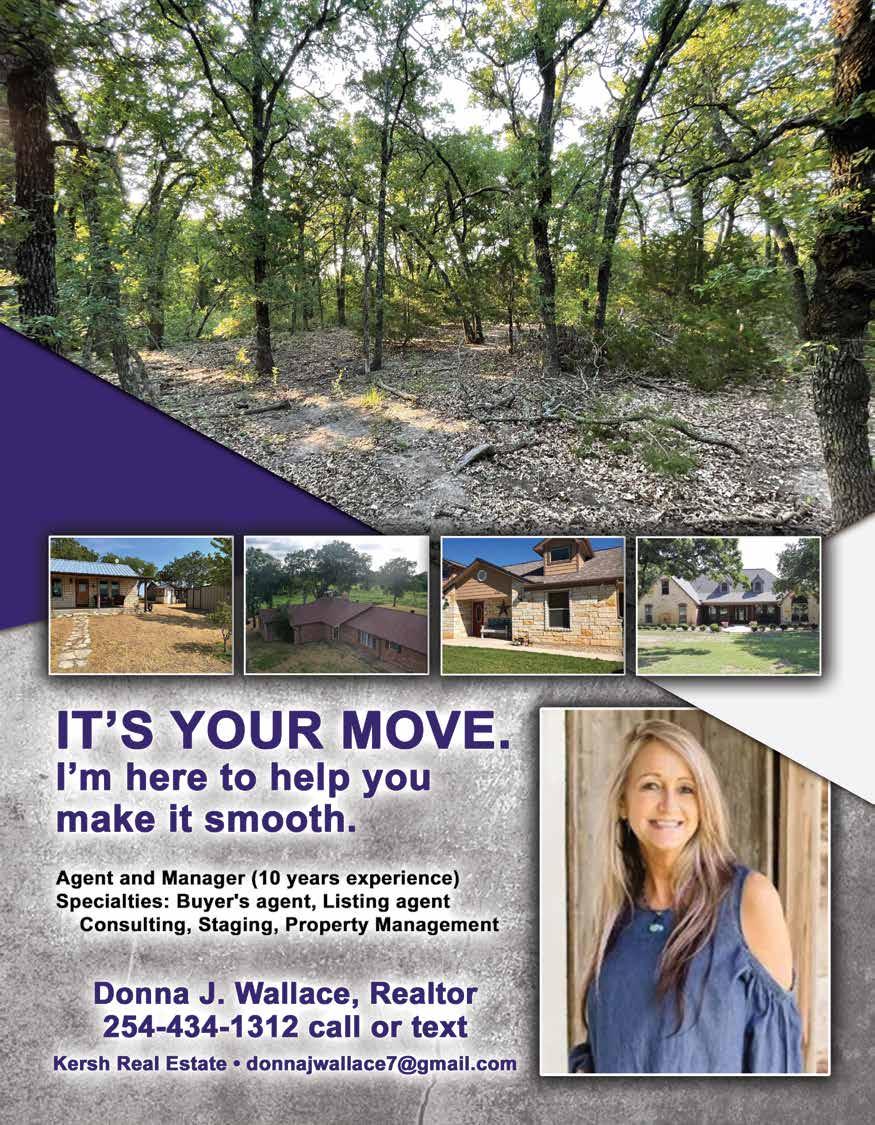
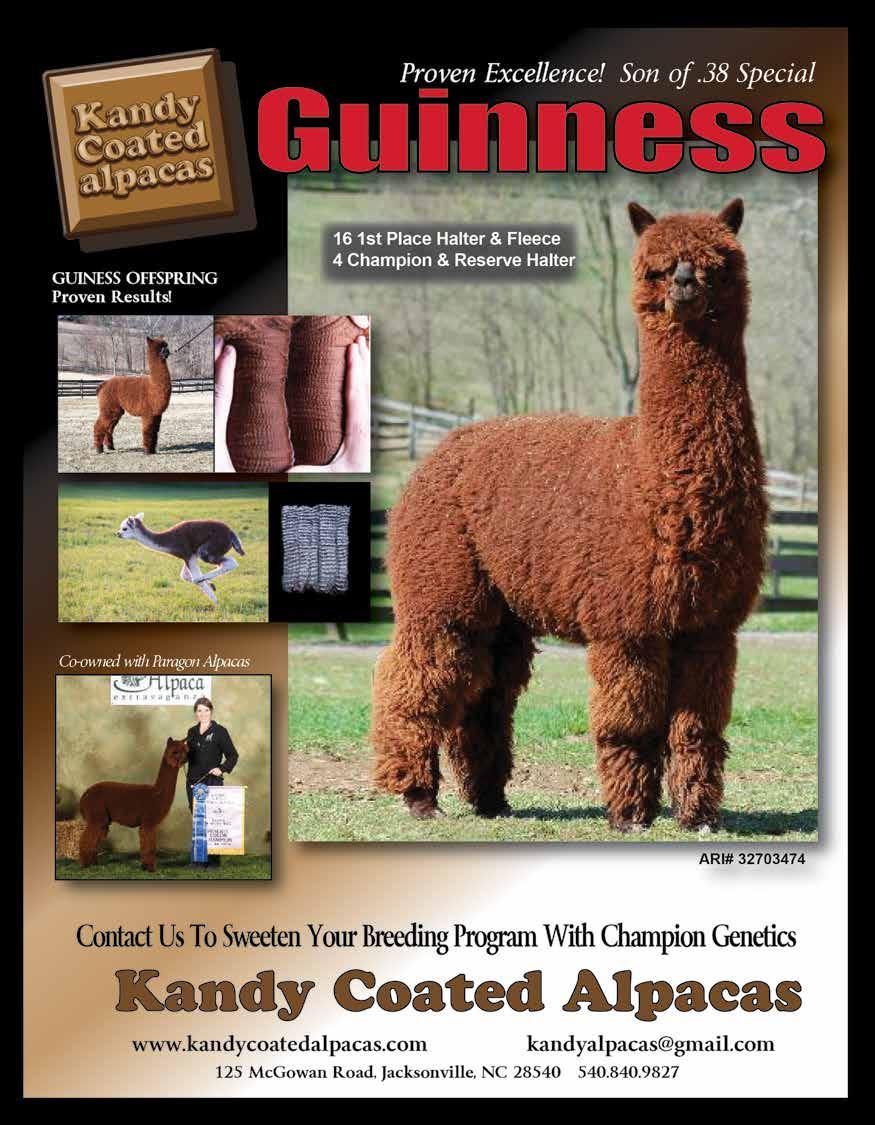
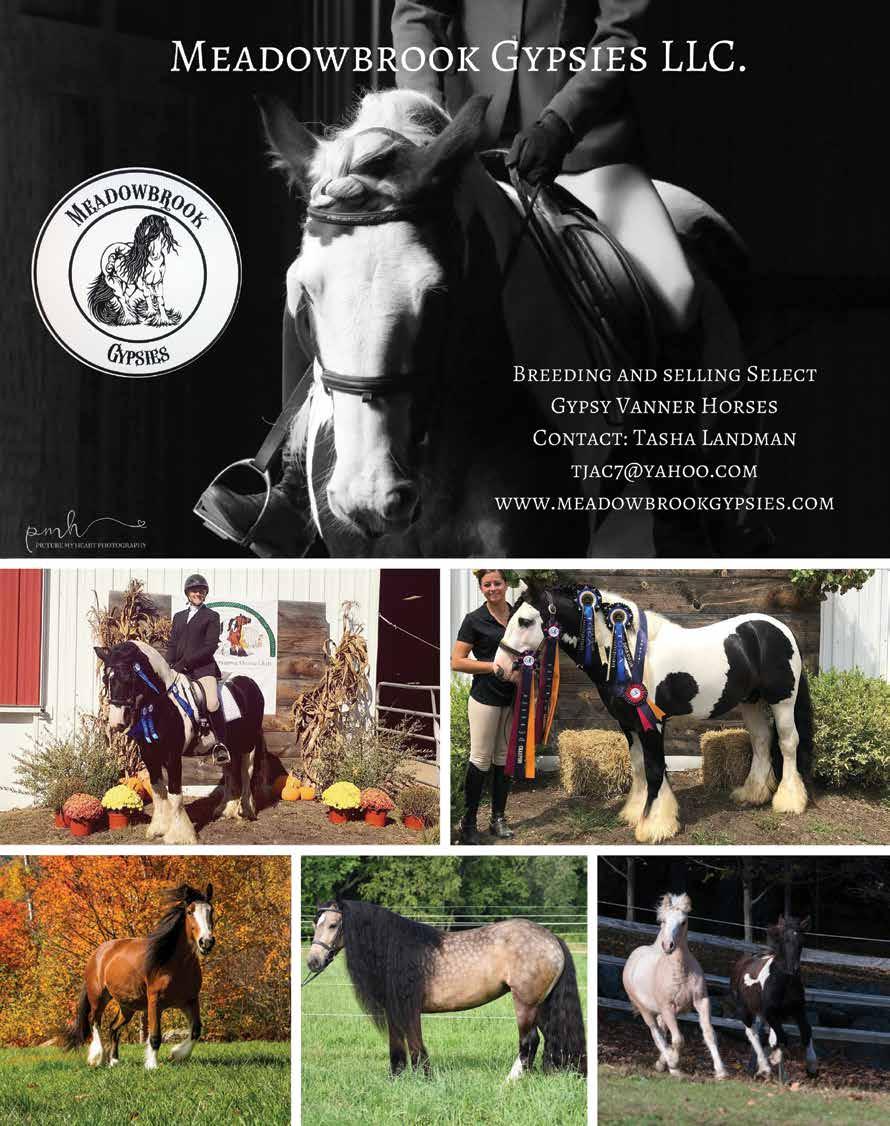

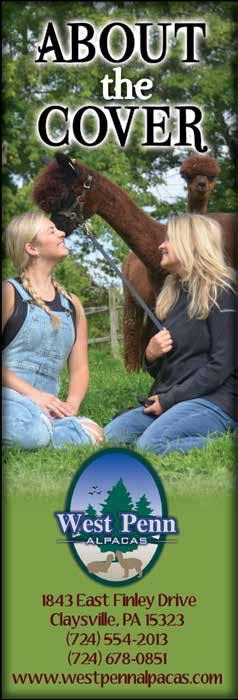
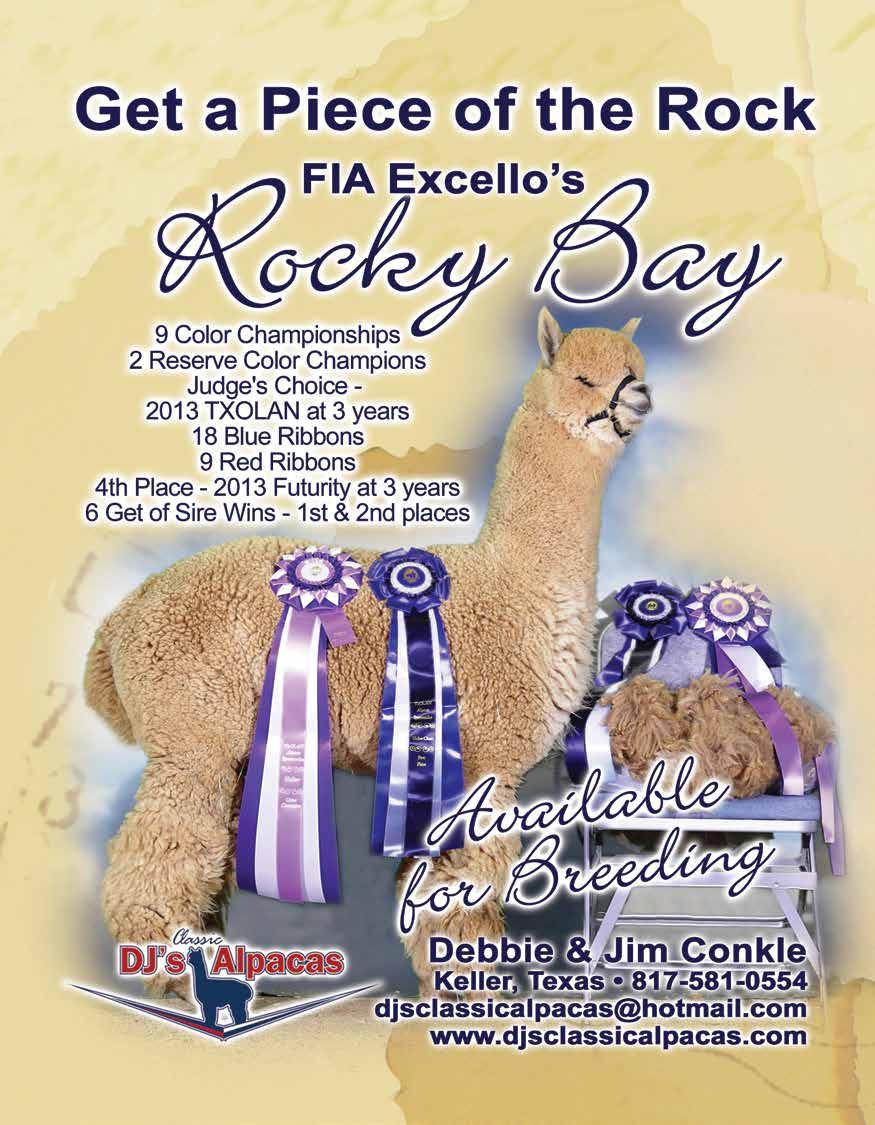







years ago, fresh out of college, Debbie Harden had an idea. She shared that idea with her parents, Dave and Billie Harden and with their support West Penn Alpacas was born! West Penn Al pacas is located on 57 acres in the rolling hills of South western Pennsylvania. The farm consists of the original farmhouse that dates to the 1800’s. The construction of six barns, an office, fiber room, vet room and a new house were all added with the growing demands of the herd and family. West Penn Alpacas started with eight Suri females and continued to grow over the twenty-six years, at one time with numbers over 300. Today, West Penn Alpacas consists of 100 of the top Huacaya bloodlines in the U.S.
A lot of growth and changes have occurred over the past twenty-six years. Debbie started a tractor deal ership, Action Equipment Center and has spent a lot of time growing the new business over the past seven years. Action Equipment Center is a proud dealer of CASE IH, Cub Cadet, Spartan, Husqvar na, Titan, and TYM Brands. Debbie’s daughter, Lexi and her boyfriend, Jon work at the dealership as well as man age the farm. Lexi is a 2020 graduate of West Virginia University with a degree in Finance. Jon is a 2021 Graduate of Slippery Rock University with a double degree in Petroleum Engineering and Physics. Debbie’s son, Wyatt also helps on the farm during the Summers when he is on break from being a full-time col lege student and a member of the Califor nia University Football team. Lexi, Wyatt and Jon look forward to continuing the West Penn Alpaca Legacy, with the help of Debbie, of course!
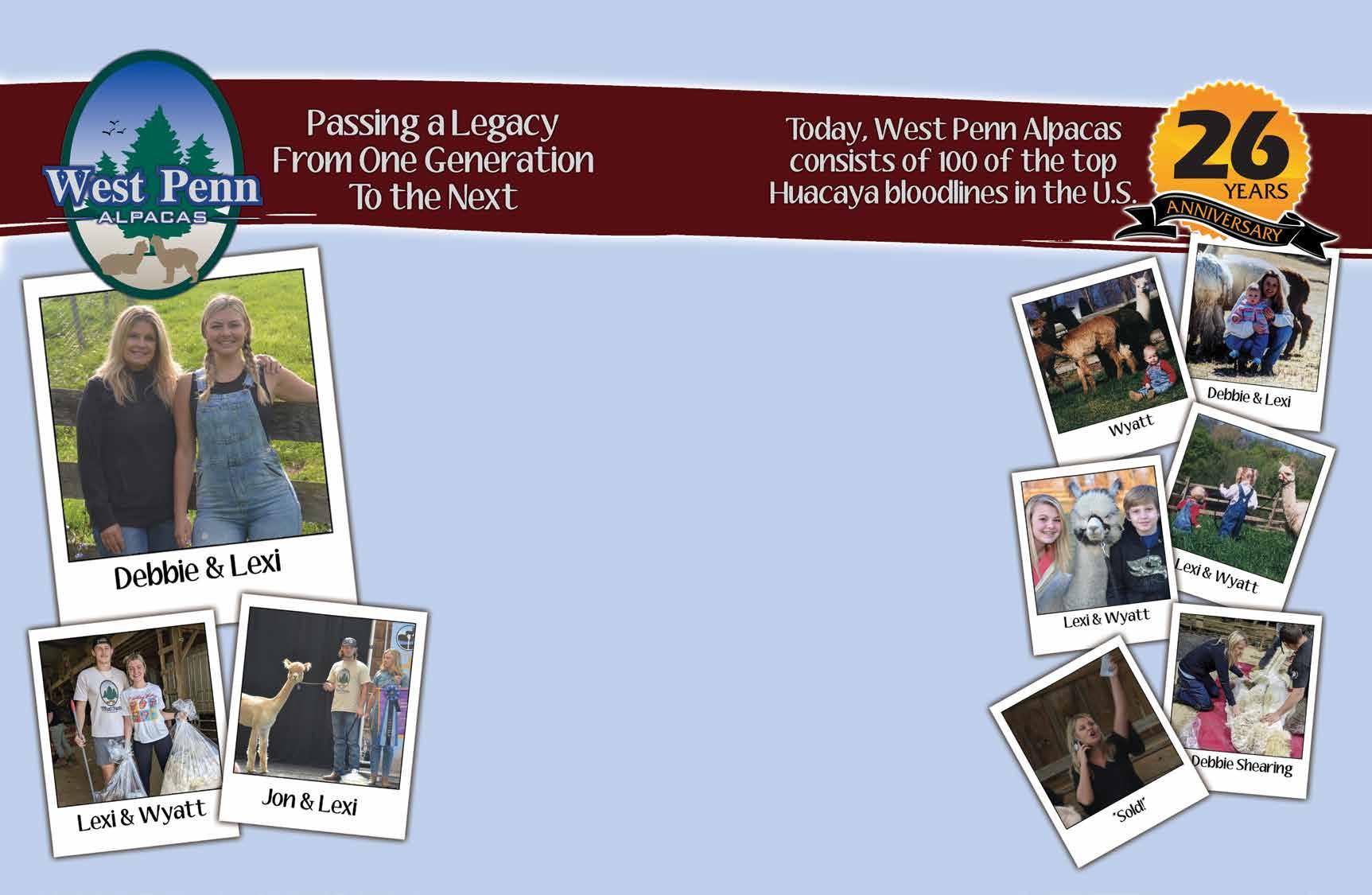
West Penn Alpacas takes pride in their breeding pro gram, adding only top genetics to their Huacaya herd. Every alpaca is hand selected and evaluated ensuring it is the perfect fit for their program. We encourage you to take the opportunity to browse West Penn’s “Stud Row” when making your next breeding decision. Two of the top herd sires that reside at West Penn are Snowmass Global Solutions and Snowmass Divine Majesty.

West Penn Alpacas has been a strong supporter of the Alpaca community over the last twenty-six years. They are a member of AOA, PAOBA, and MAPACA. Debbie has served on various boards and volunteered and spon sored at numerous shows over the years. West Penn Alpacas would love for you to stop by for a visit to meet the family and the Alpacas.
West Penn Alpacas and Action Equipment Center are not the only businesses Debbie owns; she also runs Silver Penn Sales. Silver Penn Sale is a livestock Auction company, specializing in selling high-end stock. The sales that Silver Penn Sales manage are not your typical livestock auctions; they are events! It is their goal to provide a positive atmosphere where buy ers and sellers can feel relaxed at locations where they can enjoy themselves. Whether the event is at a ranch or a casino in Las Vegas, every effort is made to accom modate every client. Silver Penn Sales takes pride in the fact that their auctions are known to be top notch and professionally managed from start to finish. Silver Penn Sales is proud to manage the longest running Alpaca production sale every June, The Parade of Champions Alpaca Auction.
Silver Penn Sales was honored to be the official livestock auction company of the South Point Hotel, Casino, and Equestrian Center for 10 years. Call Silver Penn Sales for all your Livestock Auction needs. Our fa vorite four letter word is…..SOLD!
Snowmass Divine Majesty is the son of Snowmass En chanted. This sire line is known for its showy, heavy boned phenotypes and frequent dark color with excel lent maintenance of fineness and uniformity of micron through adulthood. In fact, Divine Majesty’s fifth fleece posted grid histogram results including an AFD of 16.8, SD of 3.3 and just 0.2%>30. He is a multiple champion and Judges Choice-winning fawn who has demonstrated the ability to produce champion offspring in turn. His color genotype (Ee AA) means he can produce crias in solid colors from white to brown, and we have found his sire’s line to be a good source of modern greys as well.
Snowmass Global Solutions was winner of the 2019 Supreme National Light Champion award, Global Solutions won Judges Choice male in every show in which he was entered. He has outstanding genetics for micron-adjusted uniformity, staple length, and density. His color genotype is ee AA, and his first season’s crias, a spectacular group, ranged in colors from white to brown.
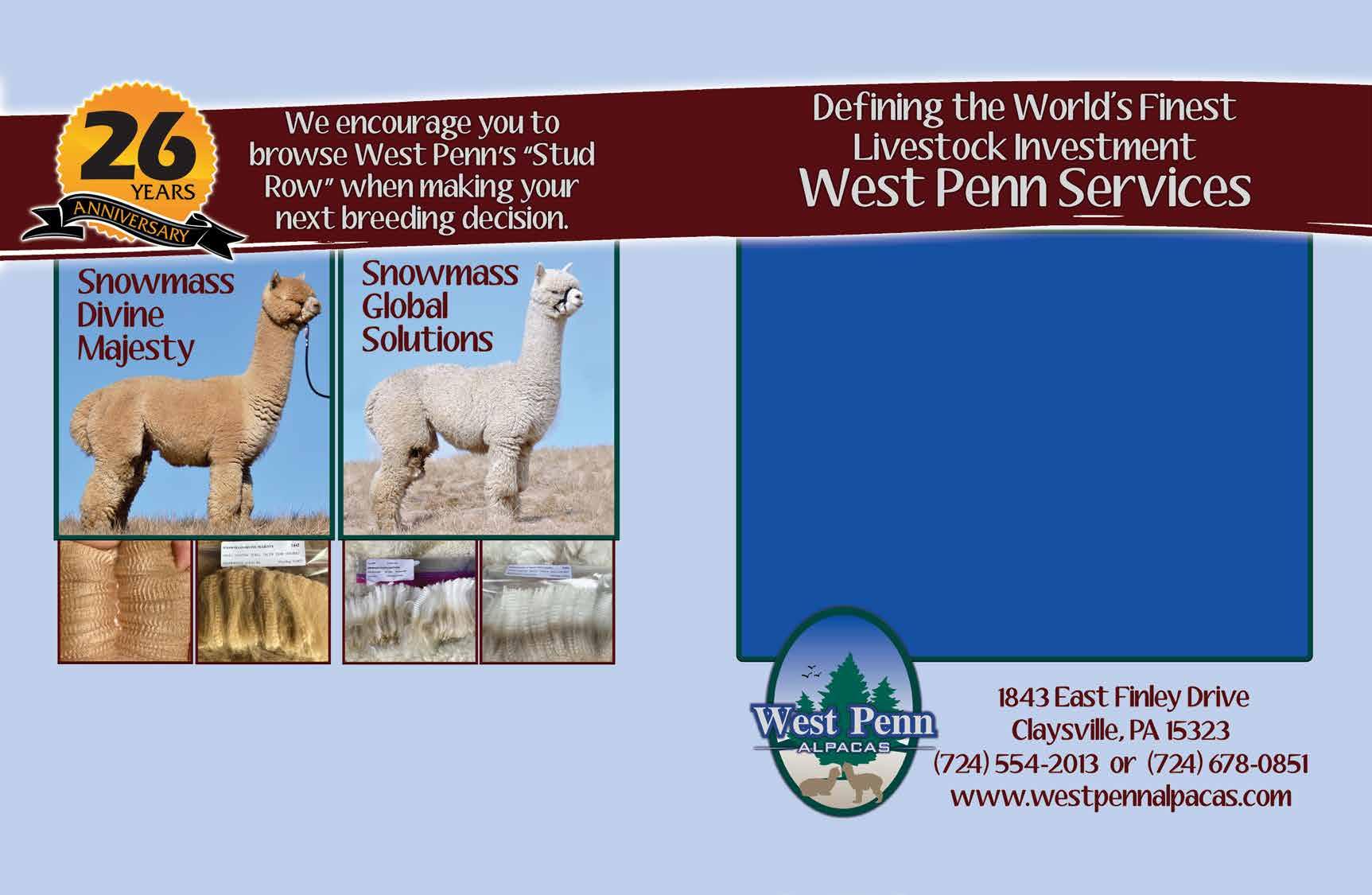
West Penn Alpacas offers full-service stud fee on all our Herd sires standing at West Penn Alpacas. This includes:
• free pre-breeding vet check
• free Herd sire selection consultation
• up to 3 months free board
• free ultrasound conformation of pregnancy
• live birth guarantee or a free breed-back
For more information, call the farm or visit our Herd sires page for a list of herd sires.
For those of you without the acreage needed to run an alpaca farm, no worries.... Board your al pacas at West Penn Alpacas! Boarded alpacas re ceive the same exemplary treatment and Vet care that the alpacas that live here receive! Along with full-service vet care we also offer halter breaking, showing services, and breeding decision consults for all boarded alpacas. Please call the farm for more information and boarding service fee sched ule.
Financing is available to all qualified clients on the purchase of 3 or more alpacas. Please contact the farm for more details.
Debbie Harden is available for consultations on alpaca purchases and breeding decision making processes. With her 26 years’ experience in the Alpaca industry, she can offer her insight and knowledge to new alpaca owners to help them at tain their individual goals.
Don’t have the time or the connections to sell your alpacas? Contact West Penn Alpacas to inquire about their “brokering program.” We will help sell your alpacas and ultimately aid in reaching your investment goals and outcome of your farm. Con tact us for more information.

Here at West Penn Alpacas, we offer on-going cus tomer support. We are available around the clock for emergency customer questions. The care of your al paca will reflect your success as well as ours.
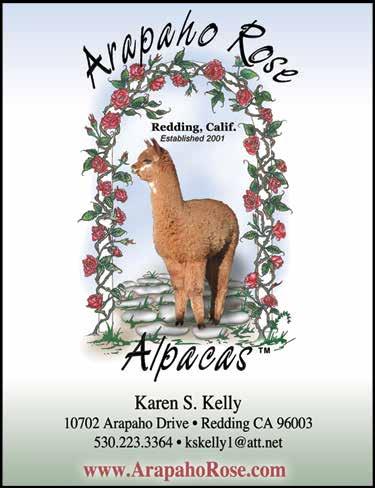


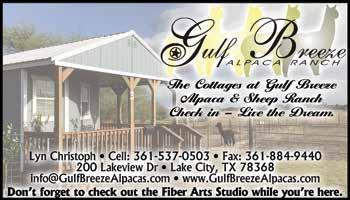


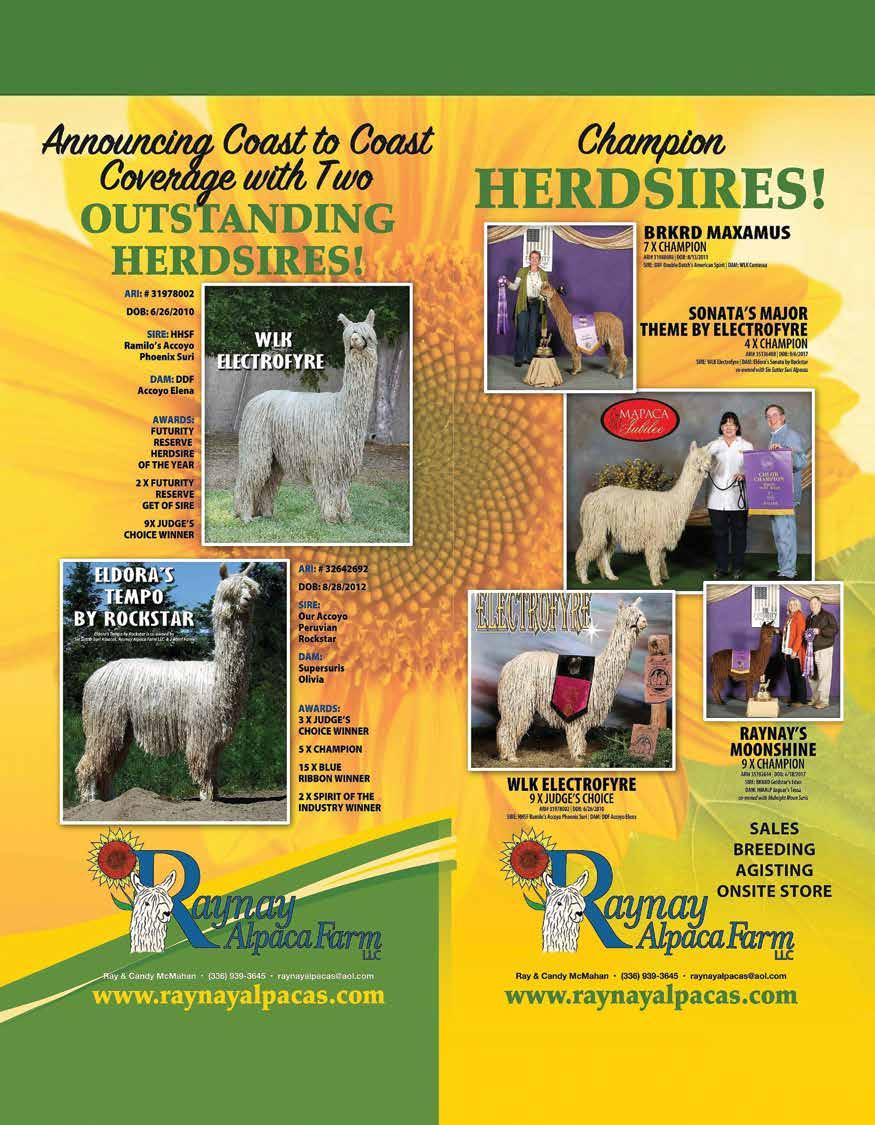
Mini Acre is a multifaceted operation, pro ducing quality fibers, products, and educating the community. Our farming methods improve the soil, produce animals that are hardy and strong, and work with the natural environment.

We started with 2 boys over 16 years ago. We now have a variety of color in our herd - solid white to solid black, pat terns and shades of grey or brown! Our focus has been on fiber from the beginning.
The ranch name comes from the miniature horses that we had prior to owning alpacas. We added an alpaca to update the logo. We’ve recently sold our miniature horses to concen trate on fiber, alpacas and llamas.
All our animals are raised on pasture by their mother. We sustainably manage our pastures, working to increase plant growth and sequester carbon from the atmosphere. Our prac tices produce climate beneficial raw fleece, yarn, and roving from alpacas that actively isolate atmospheric carbon into the soil. This is win-win for the soil, the alpacas, and people! We also promote agritourism. Visitors view our alpacas and get to learn about their history, diet, temperament, habits and uses of their fiber. You will see spinning and craft demonstra
tions, and examples of items created from alpaca fiber. Dryer balls are our top selling product created on the ranch!
Our fiber operation have expanded and we are now pro cessing other ranch’s alpaca fiber into dryer balls. The Belfast Picker and carder have streamlined the process. A rug yarn maker is in the works as well.
There are many reasons for alpacas to be raised, but one of the most popular is for their soft, luxurious fleece (fiber). Alpaca fleece has a great variety of natural colors, and each shearing produces about five to ten pounds of fleece per an imal. This fleece is stronger, lighter, and warmer compared to breeds of sheep. Alpaca fleece is hypo-allergenic and fire resistant too.
Tours are available on the last weekend of each month, weather permitting. Reservations are required and must be booked in advance through our website: www.macedosmini acres.com
Additionally, we schedule yoga, paint parties, birthday par ties, AG Days, group tours, photo shoots, and craft classes. See you soon! (209) 648-2338, or (209) 648-2384, 11175 Golf Link Rd, Turlock, CA 95380.


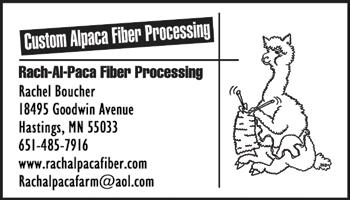
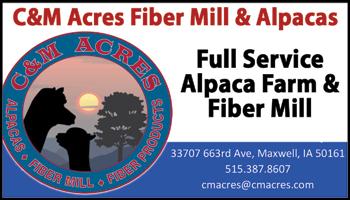
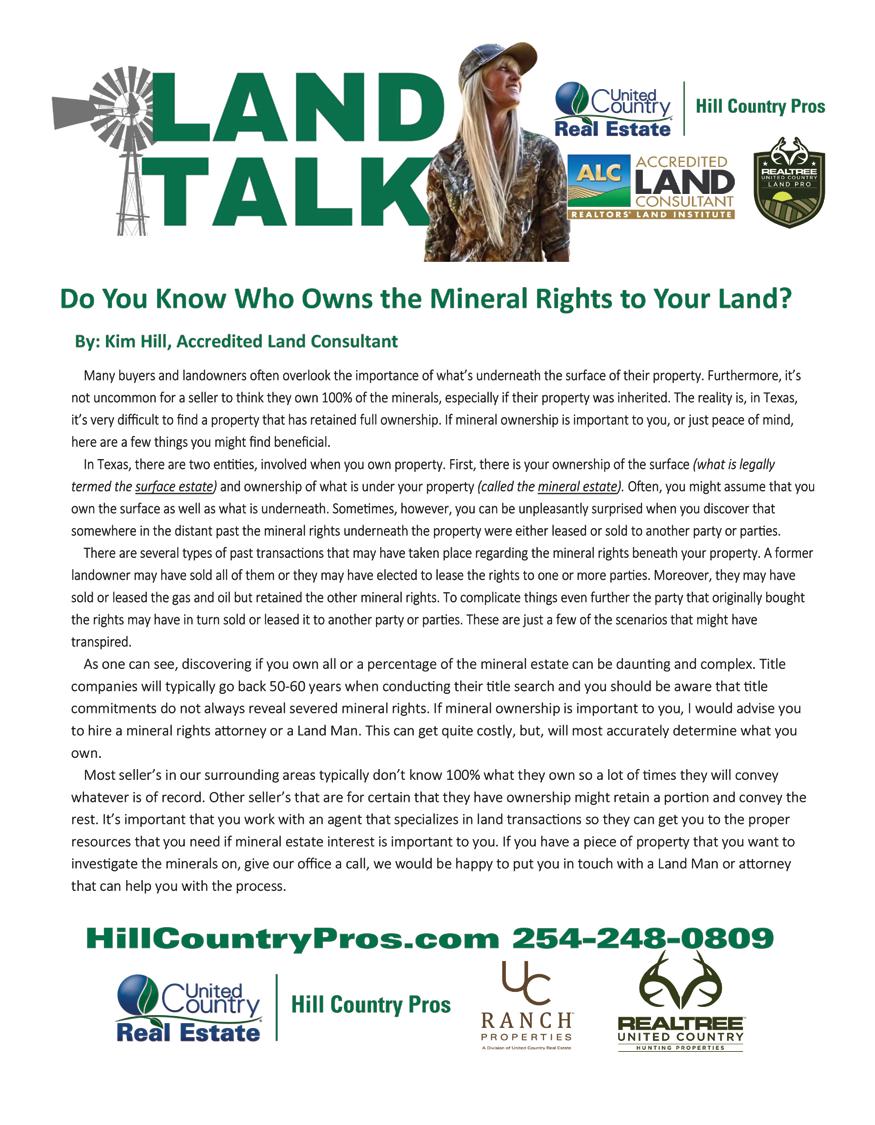
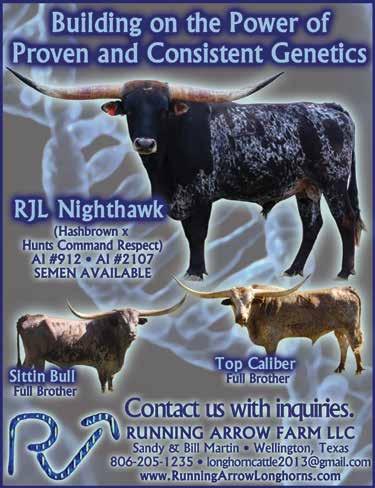
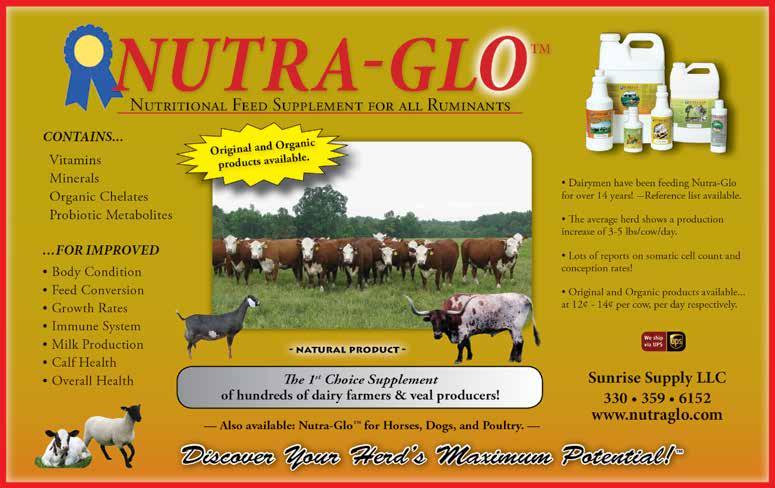
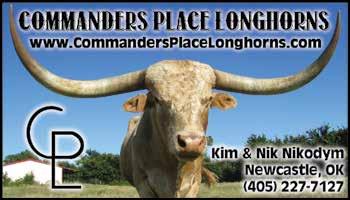

Iamoften asked by my clients what they should be doing NOW to en sure long-term success. At this time of year, I tell them, “Remember that soil microbes need to eat every day, and you’ve got to feed them!” If you were left starving and naked outside all winter, would you be ready to work in the spring? Probably not. Soil microbial life is the same; in order to keep soil vital through the winter rains, freezing temperatures, wind, and whatever other weather might come your way, then cover up your pas tures, cropland, lawns and gardens!
Since any system is only as good as its weakest link, anywhere that the cold air, raindrops, and wind can get to your soil without a carbon blanket (a cover of dead or living plant material) is an area where your system will shut down and cause you problems next year. If there are spaces between your plants, I like to think of them as holes in your land’s sweater and rain jacket. Brrrr! Even between your
cover crop plants, you want that soil cov ered! Once you get effective rotations of crops and cover crops, plant residues aka “litter” from the previous crop will ensure that you have no bare soil.
Luckily, fall, winter, and early spring are the best times to build your soil.
Usually, we have good moisture in the winter. It’s not so dry as in the heat of summer, and you can build soil struc ture rapidly – especially if you have liv ing roots and covered soil. Microbes are active even under the snow, especially if there is enough “litter” or plant matter covering the soil surface for them to eat. Cover crops are the best option for soil cover because they provide both carbon cover, living roots AND sugars to feed soil microbes directly. That means more soil structure and organic matter being built all winter so you have more wa ter- and nutrient-holding capacity next spring.
In case you are new to cover cropping

or need a basic refresher, this practice (sometimes known as growing “green manure”) uses winter-hardy plants that will be grazed, stomped, rolled, or cut down in the spring to loosen and aerate the soil. Although it is sometimes ad vised, I’ve found that it is not generally helpful to till them in to kill them in the spring, as that disturbs soil fungal net works. Of course, there are a few occa sions where doing so might be warranted as a stop-gap on your way to a manage ment approach that relies less on harm ful disturbance. One example of when you may need to till the cover crops to kill them is when nutrient cycling is re ally shut down, and you need the tillage to break down the residues, such as when transitioning heavily tilled and/or chemi cally laden soil.
When you plant cover crops in fall, you will:
• Protect the soil from compaction, erosion, wind, freezing and nutrient loss due to hard winter rains
• Suppress and reduce weeds during the winter, as well as next growing season if the residues are left on top of the soil
• Maintain and enhance soil structure
• Build organic matter and keep nutri ents cycling in the soil
• Enhance microbial diversity, num bers and activity
• Save you $$$, labor and time! Plant ing into soft, fluffy soil is much easier than planting into compacted chunks, plus it takes less weeding, watering, and inputs
To accomplish these goals, you’ll want to get the cover crop sown at least 6 weeks before first frost date. Usually, for spring grazing and planting, you don’t want to seed too early and have the plants flower before frost and snow, as they won’t come back in the spring. Depend ing on your growing zone, that generally means that ideally, cover crops should be planted before the end of September to mid-October; you want them rooted and well established before the weather gets too nasty. Sometimes you can get lucky if you are planting late, and will get a suc cessful crop, but the risk increases and benefits usually decrease after this plant ing window.
When choosing a cover crop mixture, consider that cover crop species and

functional groups are best used in com bination. If you plant them together, aim to plant a nitrogen-fixing legume with a tall crop for structural support, or use a pre-combined mix suitable for your situ ation. Use taprooted crops to help break compaction (but know that some of these are best planted earlier in late summer, so they develop a taproot before the frost and that taproot dies off and feeds sug ars to earthworms and provides holes for water infiltration over the winter!). 8-12 species mixtures are great, but you must make sure you can kill them at the right time for your spring planting and not have to use tillage or herbicides.
Below are a few easy to seed, cost-effec tive, simple mixes that will work well in the American northeast for fall seeding and rolling for an easy kill without herbi cides.
Winter Cereal Rye (NOT annual rye grass) and Austrian Winter Pea (a ni trogen fixing legume that flowers at the same time as the cereal rye). These can be mixed 64 lb per acre drilled rate; increase the rate for broadcast seeding and poorer soil conditions. They can be mixed into the same no-till drill compartment, or for small applications mixed in a bucket and thrown out together. The seeds need soil contact, and ideally plant them at a depth of ½” – ¾” into the soil for best germina tion. If you are hand seeding them, rake in and cover with mulch. You need to get them as deep as you can if you don’t have a drill… and add more to the seed rate to compensate for attrition.
If you want to get planting earlier (about 2 weeks earlier, in fact), try Crim son Clover at 12 lbs / A (it shouldn’t spread like other clovers as long as it’s
rolled down before viable seed is formed) and Barley (a winter hardy cereal grain) at 76 lbs / A. This mix is a little trickier because ideally you would plant with a technique called “alternate row” seeding. When no-till drilled, put the barley in the grain box and the clover in the legume box, but cover alternate openings with cardboard and tape so that you seed one row of barley and the next of clover. If you are at home, it’s too laborious to hand plant individual rows, so mix them and do the best you can!
One reason I recommend these 2 sim ple mixtures is because they are both easy to kill without tillage or herbicides. If you don’t have a roller – you can use a long wooden board and stomp it down (hint: tie a rope on either end and walk on it), a mower drug across with the blades turned off, or a barrel with a little water rolled across it. The pea will vine up the rye and help to kill it come spring with out herbicides or tillage. Sometimes the peas grow back up a bit after rolling, but don’t worry about this as the heat kills them.
Pro tip: These peas are great for eat ing as fresh salad greens all winter, and the sweet shoots are delicious in stir fries or raw. Their flowers are in credible and look like orchids!)
You want to roll or knock it down until at LEAST 30% of the rye and pea are in flower stage. Once it starts growing in the spring, this can happen quickly as they develop fast. It is the same garden from the first video in this blog post – about a month later!
A continuous-cover, no-till, living root 24-7 system is the best to give your microbes food, shelter and warmth to increase their number of days they are actively working for you. Cropping in a no-till organic system, without herbicides or tillage, requires thinking and planning ahead; it can get complex to choose an approach that meets your current and fu ture needs. When deciding which of the many cover crop options to use (as well as when deciding whether or not you need to seed a cover and where to seed them), it is important to KNOW YOUR WHY. I always recommend getting help from an experienced mentor to help you de cide which cover crops are best for your unique situation.
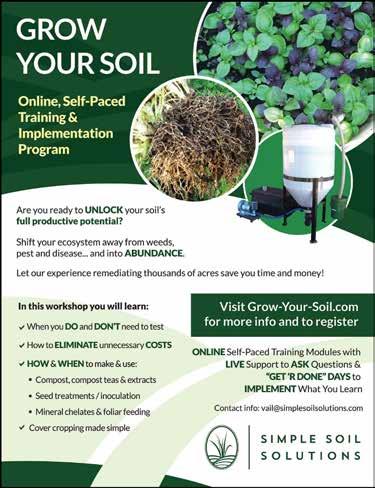
Read Vail Dixon’s post on Cover Crops at Northeast Organic Farming Associ ation of New York (NOFA-NY) Field NotesSee our Pro Tips blog entry on the Northeast Organic Farming Association of New York (NOFA-NY), which focuses on inoculants, to learn more about mak
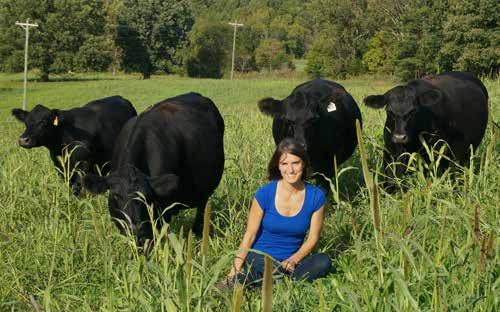
ing the most of this important practice and this vital time of year.

About the author: Vail Dixon is a regen erative farmer and holistic grazing mentor. Founder of Simple Soil Solutions, Grazing Power and Grow Your Soil, Vail grew up working on farms, climbing mountains and enjoying nature. While training to represent her country in the Olympics, a life threatening accident gave Vail an op portunity to experience healing through healthy food and natural methods – even when doctors told her it was impossible. This deeper understanding of our food and farming systems instilled in Vail a passion for healing our soils as a way to rejuve nate our ecology, economy and health.
Vail intensively researches how we affect the soil biology and how that impacts productivity and economics. Learning many ways to repair dam aged soil biologically led Vail to under stand how animals and humans play a vital role in soil regeneration. She is now building her own farm in Nelson
County VA, into a living example of and training center for Permaculture Design, Holistic Management and Biological farm ing.
Vail’s passion is joining with Nature to heal the land, our economy and ourselves. Besides farming full time, she connects with open-minded and young-at-heart farmers who want to become successful adaptive managers and create abundance on their land. To this end she is building a Holistic grazing mentorship program called Grazing Power, on-farm Grow Your Soil workshops, and Living Soils biological

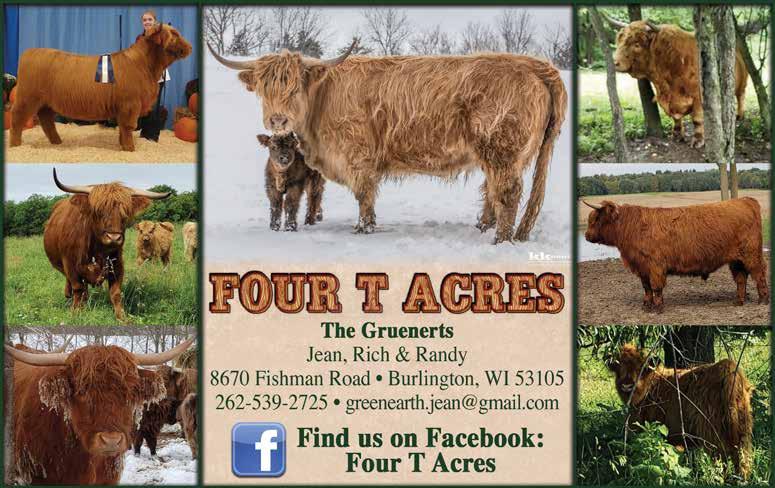
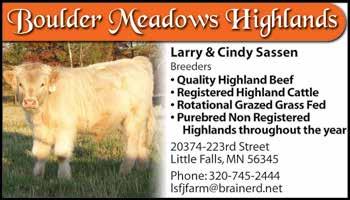



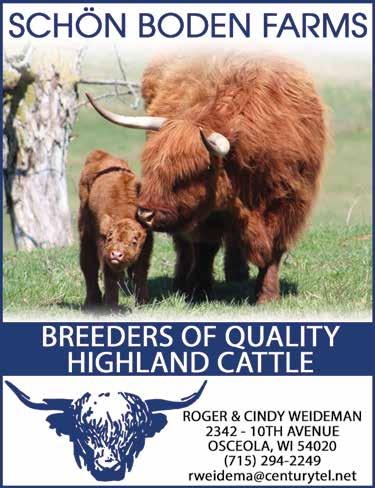
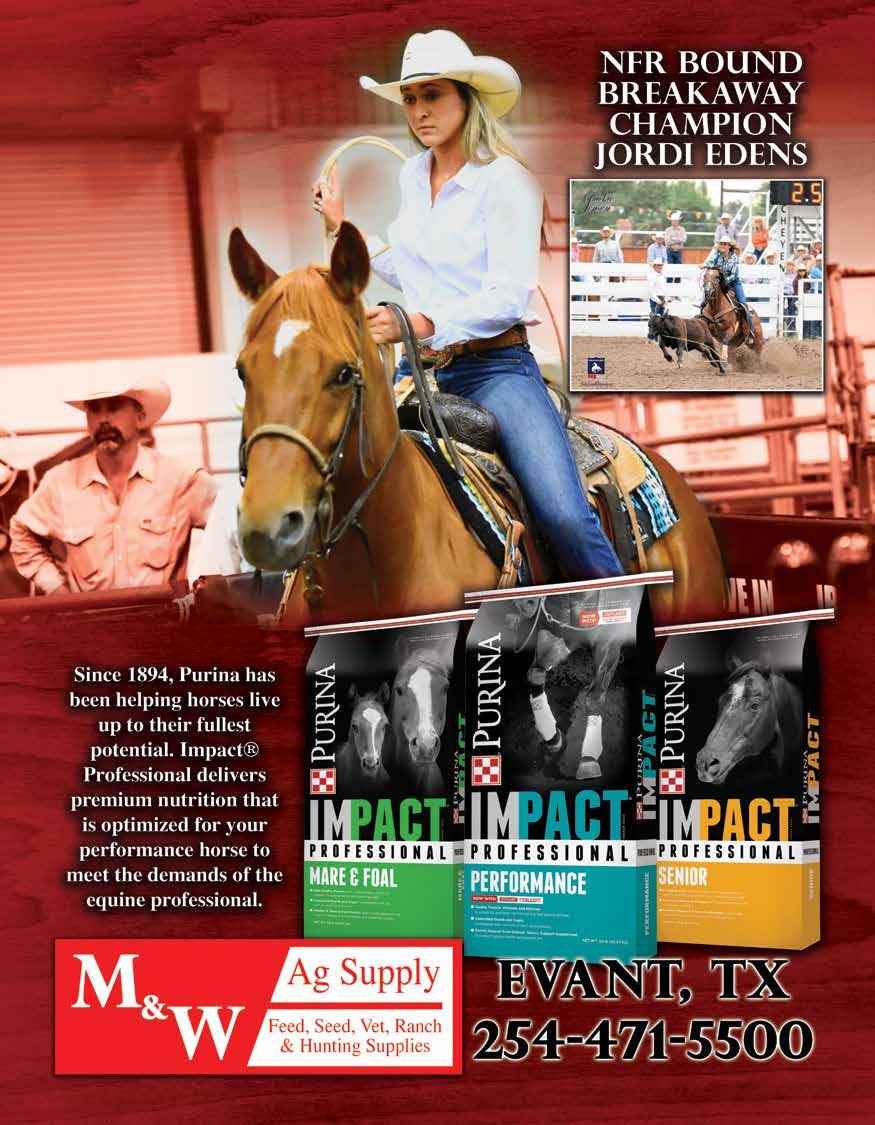
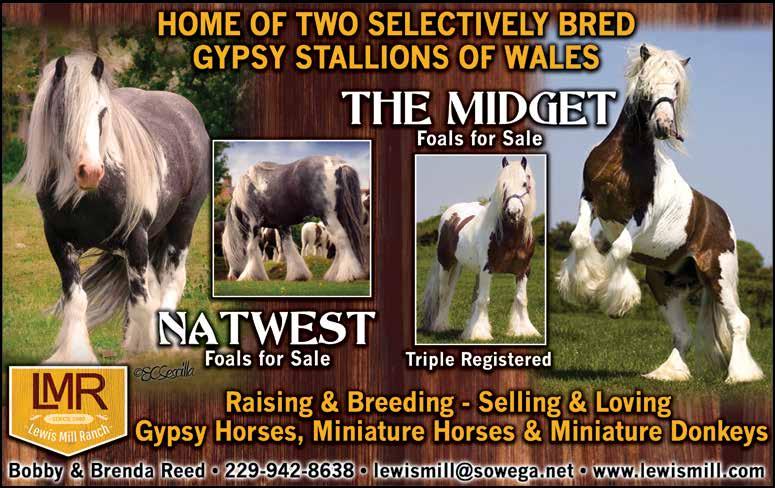

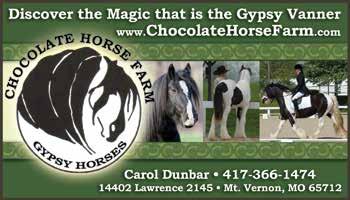
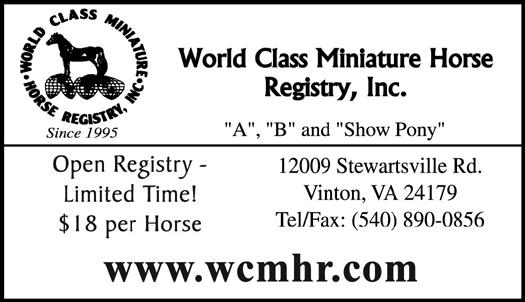

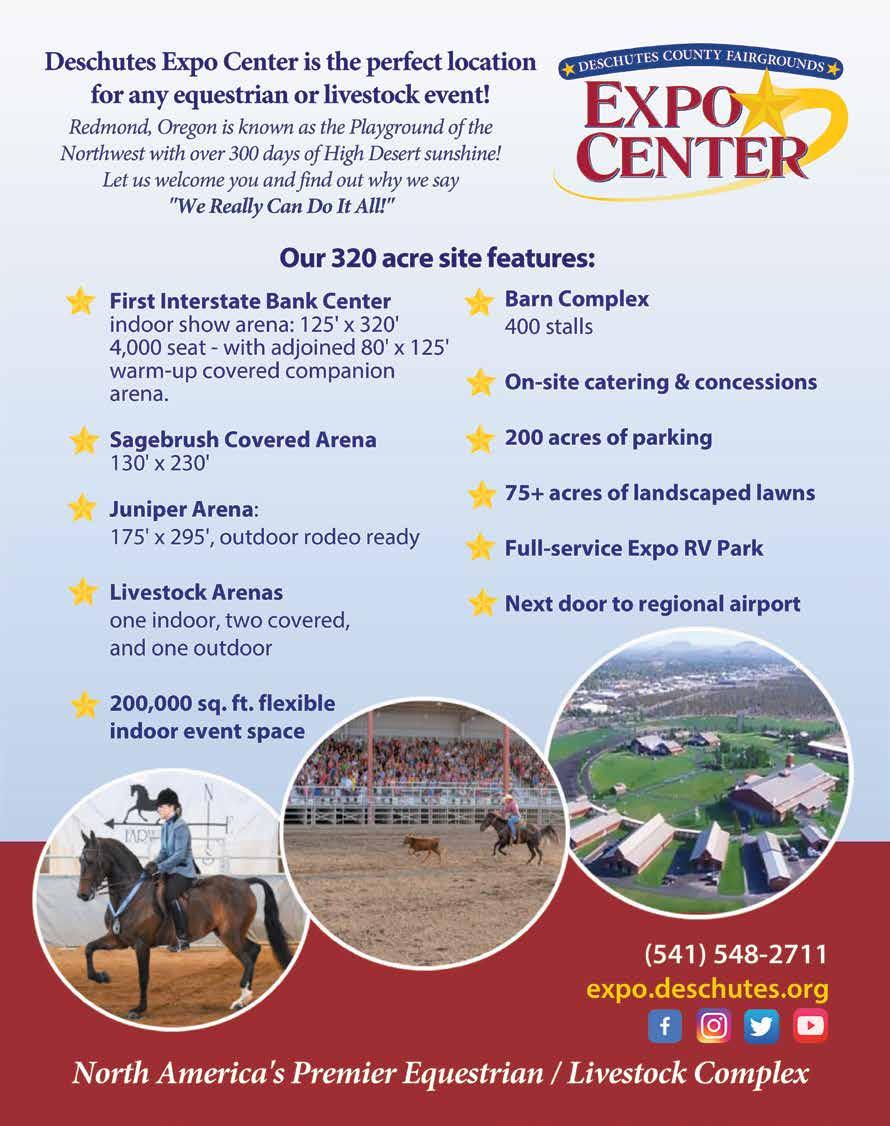
WhenCaptain Samuel “Burk” Burnett got involved in the cattle business at the age of 19 a mighty force entered the ranching business. Burnett went into business for himself with the purchase of 100 head of cattle, which were wearing the 6666 brand. With the cattle came ownership of the brand.
Burnett was born the Bates County, Missouri, on January 1, 1849, but in 1857-58 his family decided to move to Texas and chose Denton County. Jerry Burnett, Burk’s father, became involved in the cattle busi ness; since Burk was ten years old at the time, he began watching his father’s movements in the business and learned from his father.
A few years later, Burk avoided the panic of 1873 by holding over 1,100 steers he had driven to market in Wichita, Kansas. Burk held the steers through the winter, and the next year, he sold the cattle for a $10,000 profit. He was the first rancher in Texas to buy steers and graze them for market.
After that Burnett began negotiations with the Comanche Chief Quanah Parker for the lease of 300,000 acres of grassland. He not only gained the lease but also the friendship of the Chief. Quanah was the son of the white woman, Cynthia Ann Parker, who was captured in a raid of Parker’s Fort in 1836. Quanah became a great leader of his peo ple and eventually a friend of white leaders and ranchers in the South west.
Burk Burnett ran 10,000 cattle on that land until the end of his lease. Burnett had strong feelings for Indians, and a genuine respect for them. He learned the Comanche ways, passing both the love of the land and his friendship for the Indians to his family.
The lease continued until the early 1900s when the federal govern ment ordered the land turned back to the Indians. Burnett traveled to Washington, D.C. to meet with President Teddy Roosevelt. He asked for an extension on the lease, which Roosevelt granted for two years. That gave Burnett and other ranchers time to find grazing land for their herds.
Around 1900 Burnett purchased the 8 Ranch near Guthrie, Texas, in King County from the Louisville Land and Cattle Company. He also purchased the Dixon Creek Ranch near Panhandle, Texas from the Cu nard line. Those two ranches marked the beginning of the present day
Four Sixes (6666) Ranch. That along with some later additions amount ed to a third of a million acres.

In his personal life, Burk had married Ruth B. Loyd, the daughter of Martin B. Loyd, the founder of the first National Bank of Fort Worth. Of their three children, two died young. Burnett and Ruth divorced, and he married Mary Couts Barradel in 1892. They had one son, Burk Burnett, Jr. who died in 1917.
The one surviving heir of Burk Burnett was Thomas Loyd Burnett. He was born in 1871 and learned the cattle business in the 1880s and 1890s. He was educated in Fort Worth, Saint Louis and at the Virginia Military Institute. His grandfather on his mother’s side was Martin B. Loyd.
Martin Loyd was passionate about racehorses. He began amassing his own stable of fine racehorses. He branded his stock with the sin gle letter L. With his death in 1912, his interest in horses and the land surrounding Wichita Falls passed through inheritance to his grandson, Thomas Burnett. His L brand remained on his horses and is still used today.
Thomas Burnett worked as a ranch hand on his father Burk’s land, drawing the same wages as the other cow hands. His marriage to Olive “Ollie” Lake of Fort Worth produced one daughter, Anne Valliant Bur nett, born in 1900. Thomas Burnett was much admired and respected among cowmen and ranch hands.
In 1898, in bitter cold, Tom had the task of moving 5000 steers across the Red River from Indian Territory to shipping pens in Texas. He got the herd across in weather that few cattlemen would have faced.
In 1905, the Burk Burnett hosted a wolf hunt in Big Pasture, which was on land leased from the Comanche and Kiowa. Among the guests were President Teddy Roosevelt and Chief Quanah Parker.
Tom took a chuck wagon, horses and a group of cowboys to a site near present day Frederick, Oklahoma. He set up camp for the Pres ident’s ten day hunting expedition. Roosevelt, Burk Burnett and other guests had a wonderful time hunting wolves.
In a letter from Roosevelt to his son, Ted, Roosevelt is quoted as say ing, “You would have loved Tom Burnett, son of the big cattleman. He is a splendid fellow, about 30 years old and just the ideal of what a young
cattleman should be.” At age 30, Tom had already established himself as a respected cowboy and was on his way to becoming a cattle baron. He had his own ranch, leased the old ranch in Wichita County and established his home and headquarters eight miles east of Electra, Texas, Burk Burnett had maintained a residence in Fort Worth start ing in 1900. His financial king dom was headquartered in Fort Worth where he was a director and principal stockholder of the First Nation Bank of Fort Worth. He was also President of the Ar dmore Oil and Gin Milling Co, but the ranch was his main love.
He designed a custom railroad car, which carried him to Pa ducah to visit the Four Sixes. From there he hitched his horse and buggy for the thirty mile drive to Guthrie.
He built the Four Sixes Supply House and a new headquarters in Guthrie, but in 1917 Burnett decided to build “the finest ranch house in West Texas” at Guthrie. It was built for the gigantic sum of $100,000.
He employed the prestigious architectural firm of Sanguiner and Staats of Fort Worth to design the house. It was intended to be a grand home, to serve as ranch headquarters, to house the ranch man ager and to entertain guests. The stone for the house was quarried right on the ranch and the other building materials were brought in by rail car to Paducah and then hauled by wagon to Guthrie.
The house had 11 bedrooms, and it was Burk Burnett’s show place. He engaged such well-known guests as President Teddy Roosevelt, Will Rogers and others. The home was filled with amazing items. In the main room, alone, visitors were treated to hunting trophies, exquisite art and other personal items given by his friend Quanah Parker and the Comanche chief’s wives.
These priceless items remained in the house long af ter Burk Burnett’s death and through several remodeling projects. They were given by Burnett’s great-granddaugh ter Anne W. Marion, to the National Ranching and Her itage Center in Lubbock, Texas, when she inherited the ranch in 1980.
Anne was the daughter of Anne Valliant Burnett Tan dy, the only daughter of Tom Burnett and Olive Lake. “Big Anne,” as she was called was born on October 15, 1900, in Fort Worth. She was named for her father Tom’s little sister, who died young.
Like her father, Tom, Anne was a keen judge of both horses and cattle. Along with her second husband, James Goodwin Hall, she assisted in the formation of the American Quarter Horse Association. (AQHA). She was a founder of the AQHA Hall of Fame, and was the first woman named to be named an honorary vice-president by the Southwestern Cattle Raisers Association (TSCRA) and the AQHA.
Miss Anne was particularly interested in the Quarter Horse Breeding Operation at the ranch and was noted for her champions, Grey Badger II and Hollywood Gold.
In 1969 Miss Anne married Charles Tandy, founder of the Tandy Corporation. Known as a strong-willed woman, Miss Anne was called gregarious by many who knew her, and friends say that she did not pamper her daughter, “Little Anne.”
In 1921, oil was discovered on Burk Burnett’s land near Dixon Creek, and his wealth increased dramatically the discovery, and a later one in 1969 on the Guthrie property, would greatly benefit the Burnett family ranching business as it grew and developed throughout the 20th Cen tury.
Burk Burnett passed away on June 27, 1922. His will provided for two trustees to manage his holdings. The bulk of his estate was given to Miss Anne in a trusteeship for her yet unborn child.
The trustees, along with their successors, ran the Four Sixes Ranch until Burk Burnett’s great Granddaughter, Anne W. Marion (Little Anne), took the reins into her capable hands.

In 1980, Anne Burnett Marion – Little Anne- inherited the ranch upon the death of her mother, Miss Anne. Burk Burnett had listed sev eral directives stated in his will. Anne Burnett Marion sold the Triangle Ranch her grandfather Tom Burnett had developed.
A native of Fort Worth, she was the great-granddaughter of Samuel “Burk” Burnett, legendary Texas rancher, landowner and oilman. The daughter of Anne Burnett Tandy and James Goodwin Hall. Marion in herited her parents’ love of horses along with a ranch steeped in family history.
Her active involvement and management of the ranch was much appreciated by the ranch’s cowboys. The ranch was among the first in the industry to offer medical benefits and retirement plans to its staff. Marion also insisted on excellent living and working conditions and benefits for the cowboys, which inspired their deep devotion and was why so many worked the ranch for decades.
In addition to serving as chairman of Burnett Ranches, she was the chairman and founder of Burnett Oil company and president of the Burnett Foundation. In nearly four decades of the foundation’s ex istence, more than $600 million in charitable grants have been made supporting arts and humanities; community development; education; health and human services.
She served four decades as a director on the board of the Kimball Art Foundation in Fort Worth. As an honorary trustee of Texas Christian University, she contributed to numerous projects over the years, includ ing the new Texas Christian University Medical School.
She was named Fort Worth’s Outstanding Citizen; she received the
2001 National Golden Spur Award from the National Ranching Her itage Center; the Bill King Award for Agriculture in 2007; she was in ducted into the National Cowgirl Museum and Hall of Fame and into the National Cowboy & Western Heritage Museum.
She was a woman of faith and a life-long member of St. Andrews Episcopal Church. She died in 2020 from lung cancer.
Based on instructions left in Anne Marion’s will, the ranch was put up for sale for a whopping $347.7 million across the three ranch prop erties that covers land outside of Lubbock, Amarillo, and the Texas Panhandle. Though we don’t know the final sale price, we know that the Hollywood writer, Taylor Sheridan, is the face of the group that pur chased the historic ranch.
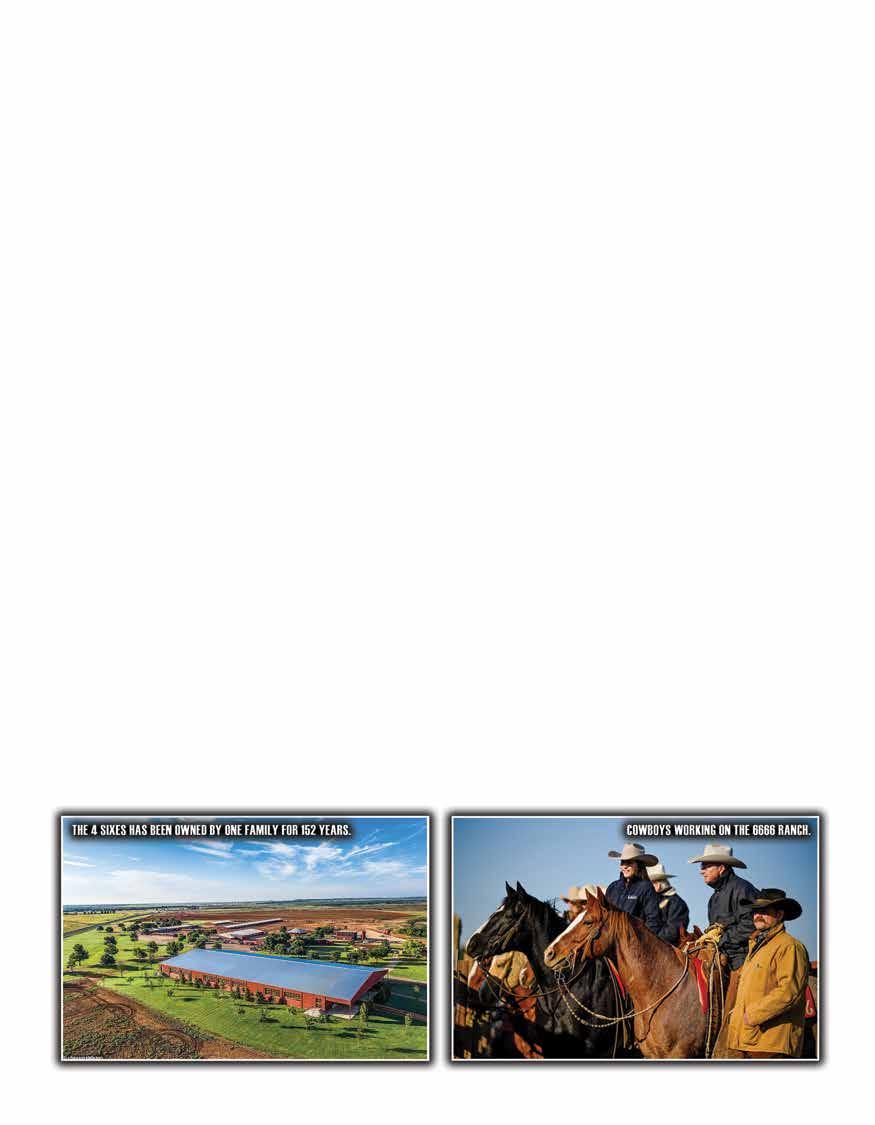
“Sheridan is the face of the buyer group,” broker Chas. S. Middleton told The Texas Spur, an award-winning weekly newspaper in Spur, Tex as. He explained that the new owners plan to continue operating the land as a working ranch and to offer continued employment to all cur rent employees. “It’s all one deal, 266,000 acres with all three ranches, cattle, horses, equipment, furniture, brand, name, everything.”
Taylor Sheridan is an actor. filmmaker, writer, director and co-pro ducer of Yellowstone, the television series that has been all the rage since it first appeared four years ago.
Sheridan is a native Texan. He grew up in Cranfills Gap, Texas, an other one-stoplight town in the state. His mother, Susan Drew, grew up in Waco, and her sanctuary was her grandparents’ ranch near the Bosqueville neighborhood. She wanted her children to similarly “have an opportunity to learn firsthand about the peaceful feeling of freedom in nature,” she says. The family bought the Cranfills Gap ranch in 1978, when Sheridan was 8. They would drive the 85 miles south from Fort Worth for weekends, holidays, and summers.
“Back then, the Gap had a hardware store, a grocery store, a feed store, and a fillin’ station,” Sheridan recalls. “And that’s about it. We were pretty isolated on the ranch. We’d get excited when the propane man would come to fill the tank.”
He may have left Texas, but Texas never left Taylor Sheridan.
“My wife’s from up in Wyoming. And my mother lives up there, so we moved there for a number of years, until I finally convinced her to come try my home state. And I moved her to Texas on August 1st, because I figured I might as well just pull the Band-Aid off quick. She didn’t understand the heat for a bit, but then she figured it out, and now she’s a Texan.
He owns two ranches outside the Dallas-Fort Worth metroplex. One is in Weatherford, which is west of Fort Worth. The other is in Jacks boro, a town about a 45-mile drive northwest of Weatherford.
“I left LA the second I could get out,” Sheridan told Cowboys and Indians magazine, a magazine for Western enthusiasts.
He used his Texas roots when he wrote 2016’s “Hell or High Water.” The movie earned him an Academy Award nomination for best screenplay.
In his interview with Cowboys & Indians Magazine, Sheridan dis cussed moving back to his home state with his wife and the importance of Texas in storytelling today.
“Being a Texan today and what it means to live in Texas--there’s a re sponsibility that comes with it, in that you really do represent the entire state,” he says in the piece.
“Everybody in Texas represents the state. And so, there’s a sense of class and confidence that I think every Texan seems to embody. And along with that, a respect for others, regardless of whether they agree with you or not. You respect their ability to disagree or agree.”
“And there’s a kindness in Texas that I find lacking in many other parts of the country. Anywhere you go in Texas, there is a genuine con cern for another person’s well-being. I just think it creates a structure of society that is very harmonious.
I’ve got a lot of people that fly in to meet with me from California or New York or where ever, and the first thing they say to me is, ‘I can’t be lieve how friendly everybody is. Everybody’s friendly and everybody’s so happy. I don’t understand it.’ It’s like, ‘Well, they’re happy because they live in Texas and they’re friendly because they’re happy.’”
Last June, Sheridan made a few remarks about purchasing the 6666 Ranch, “I can’t comment on a pending transaction, but I will say this: the legacy of the 6666 Ranch and Miss Marion’s vision for the ranch are vital not only to the ranch itself, but the rich heritage of ranching in Texas.”
He added, “This legacy is so important to me I chose to highlight it in the upcoming season of ‘Yellowstone’ and will continue to further the legacy and preserve its operations in a manner consistent with that great vision.”
In the words of Anne Marion: “The most important thing that ever happened to me was growing up on that ranch,” Mrs. Marion said. “It kept my feet on the ground more than anything else.” While her civic and cultural activities extend throughout Texas and the United States, her deepest commitment was to her birthright and the continuing suc cess of the historic Four Sixes Ranch.
We wish the new management the best of success and hope that they do carry on Ann Marion’s legacy. I am deeply indebted to a number of sources. The website for the 6666 Ranch was full of useful information and gave me a feeling of the continuity and people involved. The Spur, the weekly newspaper from Spur, Texas, as has been quoted a number of times as has Joe Layton’s article on Taylor Sheridan in January 2021of Cowboys and Indians; The Texas Monthly interview with Taylor Sheri dan by Dan Solomon in June 2021 was also used.
“The most important thing that ever happened to me was growing up on that ranch,” Mrs. Marion said. “It kept my feet on the ground more than anything else.” While her civic and cultural activities extend throughout Texas and the United States, her deepest commitment was to her birthright and the continuing success of the historic Four Sixes Ranch.



Ifeverything’s bigger in Texas, then that includes the agriculture industry. One of our Lone Star State’s top commodities is the sale of cattle and calves which contributes to Texas agriculture’s total economic impact that reaches $115 billion annually.
Cattlemen in our Central Texas area work their cattle in diverse manners. There are as many sce narios as there are cattle owners. There’s no right way to do it; only distinct preferences. Cattle breeds and crossbreeds have differing temperaments. That calls for different methods of penning and sorting. Some stockmen now seek more calm ways to work their cattle. Their belief is that quieter han dling is safer, more productive, and will yield high er financial gains.
As humans, we have become very aware of how stress negatively impacts our own physical health. Some may say it’s also true for cattle. There’s re search to show that stress adversely affects the ani mals and thus the productivity. Stressed-out bulls
can be more prone to aggression and unpredictable behavior, which, in turn, can lead to costly, preventable accidents to the handlers. Con versely, research points to cattle raised in a low stress environment gain weight faster, produce more milk, and are less prone to injury and dis ease.
The foremost authority in the U.S. on the safe, calm handling of cattle and the benefits derived is Dr. Temple Grandin. Livestock owners, cattlemen, and ranchers in our area may be familiar with her name in that vein. In addition, movie buffs might also recognize her name because in 2010, Temple Gran din, the American biographical drama film starring Claire Danes, was released. The film won many national accolades including seven Emmys for its depiction of Dr. Grandin’s life and achievements. Furthermore, current events enthusiasts may possi bly recall her being named one of Time Magazine’s 100 Most Influential People in the World in 2010.

Dr. Grandin is a professor of animal science at Colorado State University in Ft. Col lins, CO. She is an internationally known consultant to the livestock industry on animal behavior and is also an autism spokesperson. She is one of the first individuals on the autism spectrum to publicly share insights from her personal experience of autism. She uses her knowledge to revolutionize practices for the humane handling of livestock on cattle ranches and in slaughterhouses.
When interviewed by Stanford Medical News Center, Dr. Grandin was asked “How does autism help you connect in a unique way to animals?” She replied, “Autism helped me understand animals because I think in pictures. Since animals do not have language, their memories have to be sensory-based instead of word-based. This was a new idea to look at things that cattle were seeing.”
Dr. Temple Grandin shared with our magazine her studies on animal welfare and low stress livestock handling in the abstract that follows. “Careful quiet handling will help improve productivity. Cattle that become agitated in the squeeze chute or run fast out of it have lower weight gains. Carefully acclimating cattle to moving quietly through the handling facility will improve conception rates when they are brought back into the facility for AI (artificial insemination). Acclimating young cattle to people walking through them will produce calmer, easier to handle adult animals. Research has also shown that acclimating animals to both chutes and transport lowered cortisol levels and heartrate. Animal memories are specific and acclimation to one situation may not transfer to another situation. Practical experience in the field clearly indicates that cattle that are completely habituated and have a small flight zone when a person on horseback rides through them (whereas they) may run away when they are suddenly confronted by a person on foot. A person on foot presents a totally different image compared to a person on a horse. Neuroscience research clearly shows that mammals have circuits in the brain for perceiving fear. Handling during transport and at the slaughter plants are areas where poor handling can compromise welfare. Quiet low stress methods will reduce costly bruising and death losses. During the last five minutes before slaughter, excitement, agitation, or electric prod use will increase lactate levels which may increase tough meat in cattle…”
From her own website, Dr. Grandin notes that curved, solid panel cattle chutes are more efficient for handling cattle because they take advantage of the natural behavior of cattle which is especially important if cattle aren’t accustomed to being handled. Block ing their vision eliminates escape attempts and lowers stress levels. Cattle move through curved paths more easily because they have a natural tendency to go back to where they came from.

Dr. Grandin has the unique ability to visualize the paths the cattle take and has made drawings of cattle yard designs for both large and small ranches and feedlots. She has also designed cattle loading ramps for trucks, diagonal stockyard pens for cattle, and de tailed drawings of a single file race and of cattle dip vats. Her cattle pen layouts result in reduced stress on cattle and improved handling efficiency. Livestock owners, cattlemen and ranchers benefit from working and loading cattle with less stress, as they will bring more at market and thus will be more profitable.
Trenton Koether, of T Bar K Construction in Hamilton, has built cattle pens to Dr. Grandin’s specifications locally. The owner of the pens wanted to keep his cattle safe without harm to them or to the handlers. Trenton pointed out that, “The owner worked closely with the drafter who draws Dr. Grandin’s plans. She knows how cattle think
and process. He draws them up and she tweaks them. They are de signed to keep the pens quiet so the cattle flow and don’t get tense or nervous. The owner wanted pens so that he and a handful of people could work the cattle and not stir them.”
The pens are built from Dr. Grandin’s design, but the owner mod ified the gates and latches to his preference. Once the plans were finished, he handed Trenton a binder with the designs and let him go. Trenton then familiarized himself with the details and layout. He made out a materials list along with a price list and began gathering resources.

The rancher chose the location and had the area cleared, flatened and squared off. He had creek gravel hauled in to level it, to limit stirring dust up, and to aid in keeping the enclosures clean. The pens took about ten months to build with four months on the corral. The buildings erected near the pens were built by another crew. Together, the pens and buildings provide a very safe, quiet, easy way to work cattle.
Trenton pointed out that the shady, serene, surrounding pastures are somewhat pie shaped so that the fences converge into the pens. That, in itself, makes for easier movement of the cattle. Once the cat tle are penned, they are sorted into six numbered pens until it’s their turn to go into the working area. There are two gates on the holding pens that are solid and 2 feet longer than the adjacent alleys. Trenton said, “What that means is that the gates never open perpendicular to the holding pen. They always open toward the direction the cattle are to be moved whether in or out of the next pen.”
As one pen of cattle is gently pushed toward the working area, Trenton noted that handlers use personnel gates which allow them to step onto the walkways on the outside of the alley and reach over with their rattle paddles. Since the alley walls are 6’ solid metal and curved, the cattle naturally approach the next opening. The concrete floors of the alleys are scored to prevent the cattle from slipping. As they progress toward the tub, solid gates are closed behind them.
Once in the tub, Trenton demonstrated that the crowding gate could be slowly moved in two-foot increments to coerce the cattle into one of three directions. Gates inside the tub control the path. The tub opens to an elevated chute to load cattle onto a truck. It also opens to a ground level chute so that cattle can be loaded into a trail er. The third option is to push the cattle into the narrow “V” shaped chute that leads to the actual working area.
A bump gate that falls behind them prevents the cattle from mov ing backward once they are in the “V” chute. Again, there are walk ways and personnel gates all around the chutes to allow handlers to move the cattle without having to be in the chute with the animals. As the cattle slowly move into the building that houses the working area, they are under as little stress as possible.
Trenton then revealed the inside of the building with wide, top-rolling doorways on both sides where the animals enter and exit. Each animal individually is calmly loaded into a hydraulic squeeze chute. This chute is amazing as it allows the rancher and his handlers to achieve several important health checks all at the same time and place. He demonstrated that the squeeze chute weighs the animal and holds them in place with rubber bumpers around the neck and along their sides. All this is done at the flick of a switch. The rancher is able to inoculate and treat any noticeable problems. The chute also slowly leans to either side so that the rancher can trim hooves, cas trate calves and the like.
Three water hydrants dispensing hot, cold, and non-potable water are nearby to meet any needs. Hooks on the walls store stools, small tables, rakes, shovels, scoops, brooms, etc. neatly out of the way when not in use. Nothing remains on the floor of the working building at the end of the day. Drains in the floor allow the rancher to keep the facility spotless.
Next door inside the same building is an air conditioned room that houses a deep stainless steel sink, cabinet for supply storage, racks for buckets to drain, a desk for recordkeeping, and a refrigerator for stor ing veterinary medicines. The noisy generator that supplies power is outside the building so that the working area remains quiet and calm during the actual cattle working.
When all the necessary medical checks have been made, Trenton stated that the cattle are released into yet another set of numbered holding pens. For instance, sometimes mama cows are sent to one pen while their calves are sent to another so that the calves can be weaned. Other times, bulls are released to a secluded pen. There are ample, clearly-numbered pens to sort the cattle any way necessary.
Besides the pens at the original site, the rancher has built two more remote pens on other parts of his ranch he refers to as Phase One and Phase Two. He plans to expand these sites similar to the existing Grandin pens, as well, so that he has the same productivity on every parcel.
This state-of-the-art operation is clearly efficient. Dr. Grandin’s plans work just as she envisioned. It’s easy to recognize that this setup is an innovative method of working cattle. The rancher’s labor costs are reduced because only a few additional cowhands need be em ployed for a short period of time. Since profits are the bottom line and said profits are linked to quiet, calm handling of cattle, the effort to build and utilize Dr. Grandin’s designs are worth every penny.
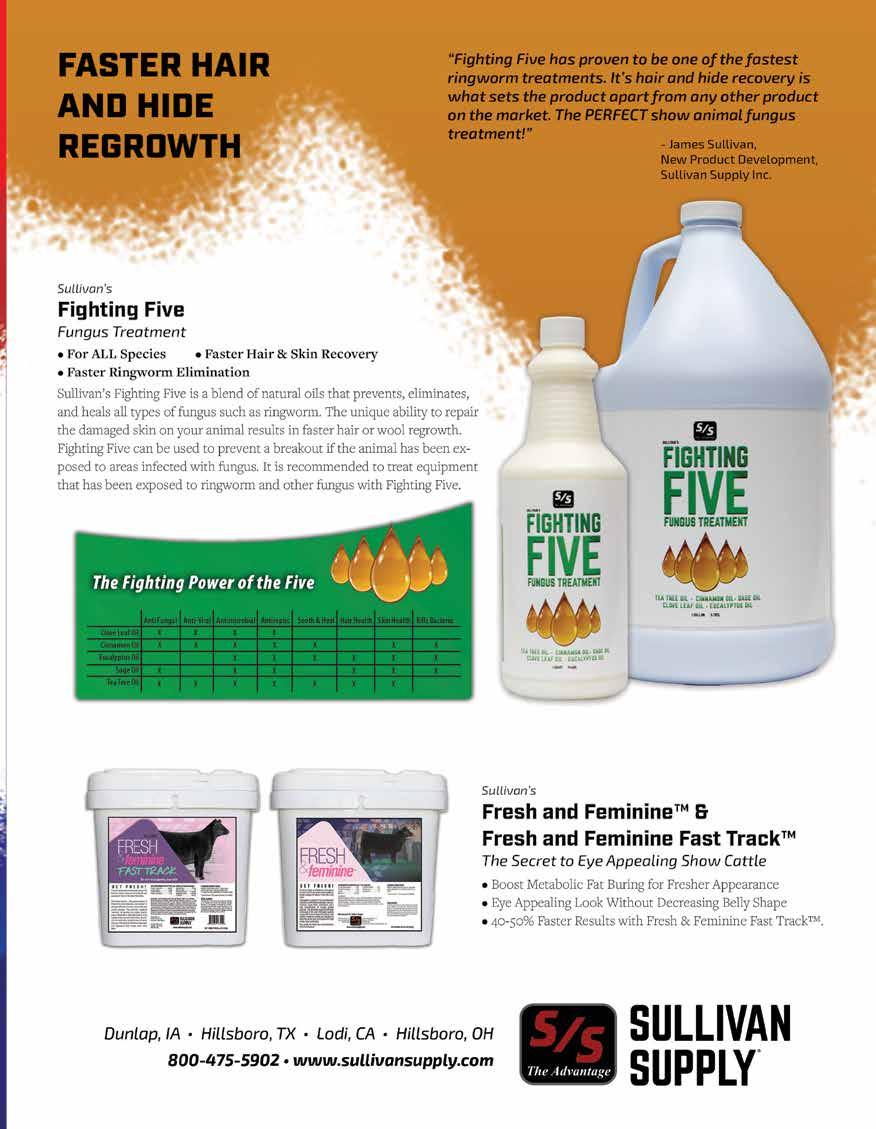

a lot of people saying that they want to 'do it right' when they start regenerative grazing. That is a noble goal, but in truth it's a hard one to nail down.

Do it right for whom? The animals? The soil health? The wildlife? For you? None of these can be separated from any of the others. It is always a balancing act because so much de pends on other factors that may be out of your control, like the time of year, animal status, weather, your health and time availability.
The difference in advice from experts should give us a clue that there is no perfect way to regeneratively graze. The experts' recommended stocking densities vary dramatically from 3000 Animal Units/Acre to 300,000 Animal Units/Acre. Which one is right? You may be surprised by my answer.
Let's talk about four common misconceptions of 'Doing it Right':
I want to do it right, from the start!
The higher the stocking density, the better! The more you move the better it is!
I don't want to have to feed hay!
I want to do it right, from the start!
Well, the bigger issue is just to get started! I procrastinated for about 15 years before actually starting. I made the decision to rotationally graze 20 years ago, got the gumption to buy the netting 15 years ago and it sat in the barn for 10 years. I genu inely STARTED moving my animals 5 years ago. There really is no wrong way to start. You just have to get out there and watch your animals and your forage and start trying different things. Everyone's farm is different, so you are not behind, and you aren't doing it wrong. If you are thinking about it and asking questions and making an effort, you are doing it right!
Greg Judy tells a story about an elderly grazer who desperate ly wanted to start rotational grazing after hearing Greg speak. After thinking it through, Greg helped him set up a single line through his pastures, splitting his pastures into two paddocks. The farmer was tickled pink. Was it the right way to do it, with only two paddocks? Yes, indeed, in this case it was. He didn't have the physical ability to move a lot of fencing and waterers on a regular basis, so this was the best alternative. 'Right' is a rel ative scale which has to include the farmer's life factors, including health and available time.
I took an Introduction to Holistic Management course this past fall, and the biggest sur prise for me was that only a tiny portion of the course taught us about actual grazing. The rest was evaluating my goals, my fami ly's goals(!), my facilities and my available time in order to figure out the best solution for my farm. In figuring out the 'right' way to do things, we have to take a holis tic view of all of the factors in the farming equation.
The higher the stocking density, the better!
It looks like mob grazing
(very high densities for very short durations and at least 45 day rests) may not be as beneficial as initially thought. Look up Dennis Hancock's summary of the scientific literature on mob grazing. His research shows that mob grazing comes in second to rotational graz ing in areas such as ani mal performance, organic matter, consumption vs. trampling, mulch left, soil temperature and moisture, and soil compaction. These are all of the things that I thought were important and would become better if I increased my stocking density. Evidently, pushing the system toward mob grazing is not the holy grail of grazing. You can stop stressing about trying to push for higher densi ties! It's not necessarily the 'right' way to regeneratively graze.
The more you move the better it is!
I know a woman who moved her cattle four times a day. Yeah, that's a LOT! Did her animal performance improve? Why yes, unsurprisingly, yes it did. Did it run her ragged? Actually no. She was going through a rough patch and needed that quiet time to herself and with her animals. It brought her peace and joy. Note that she did not continue this long-term because her life changed again, and she was no longer able to spend that time moving the animals. That was OK too.
Moving your animals can be really good for them, but it may at the same time be really bad for you. Sometimes life doesn't let you enact your plans like you want. You can always drop back to Plan B. And that's OK.
I don't want to have to feed hay ever again!
This is probably the goal I hear most from regenerative graz ers, and to be honest I had this goal until just recently. Going without hay is possible, even in the driest drought, as long as I am willing to partially (or fully) destock. That's a tough one for me, especially since I've become attached to my breeding stock.
My hay feeding went down by 50% the first year I regenera tively grazed, but I learned in the following years that feeding hay was not a bad thing. It serves several stacking functions. In the winter, if I feed by spreading the hay out on new pas ture every day when needed, I feed the animals and give hab itat and food to the soil microbes. Hay covers the soil to keep the pounding of raindrops from loosening the top layer of soil during a storm, causing erosion. Feeding hay in the spring
along with lush grass keeps the animals' diges tive systems going and prevents bloating and the squirts. Hay gives me in finite options to hold my animals back in the sum mer if the next paddock is not ready to graze. I have found, for now, that my regenerative grazing includes hay every season of the year.
My pastures have responded energetical ly to this treatment. The forage is SO much better than it's ever been, and my stocking rate has in creased by 50%. Eventu ally I may be able to cut back on my hay some, when I get my soil health really hum ming, but I never plan to go hayless. Do some people go hay less? Yes. Are they doing it right? Probably, because it would be cutting into their bottom line if not. Am I doing it right? Definitely. For me, for now.
Don't hold yourself to an impossible ideal of how to do it 'right'. Do your best to nurture your animals and soil health, but don't forget to nurture yourself. Just like in the airplane safety demonstrations, if you don't take care of yourself first, you won't be able to take care of others (including the animals and all of those lovely soil microbes!)
Healthy soils to you!
About the author: Kirsten Robertson is a regenerative farmer, pasturing goats, sheep and chickens in South Carolina. Visit her new blog at RegenaGraze.com to learn more about her.
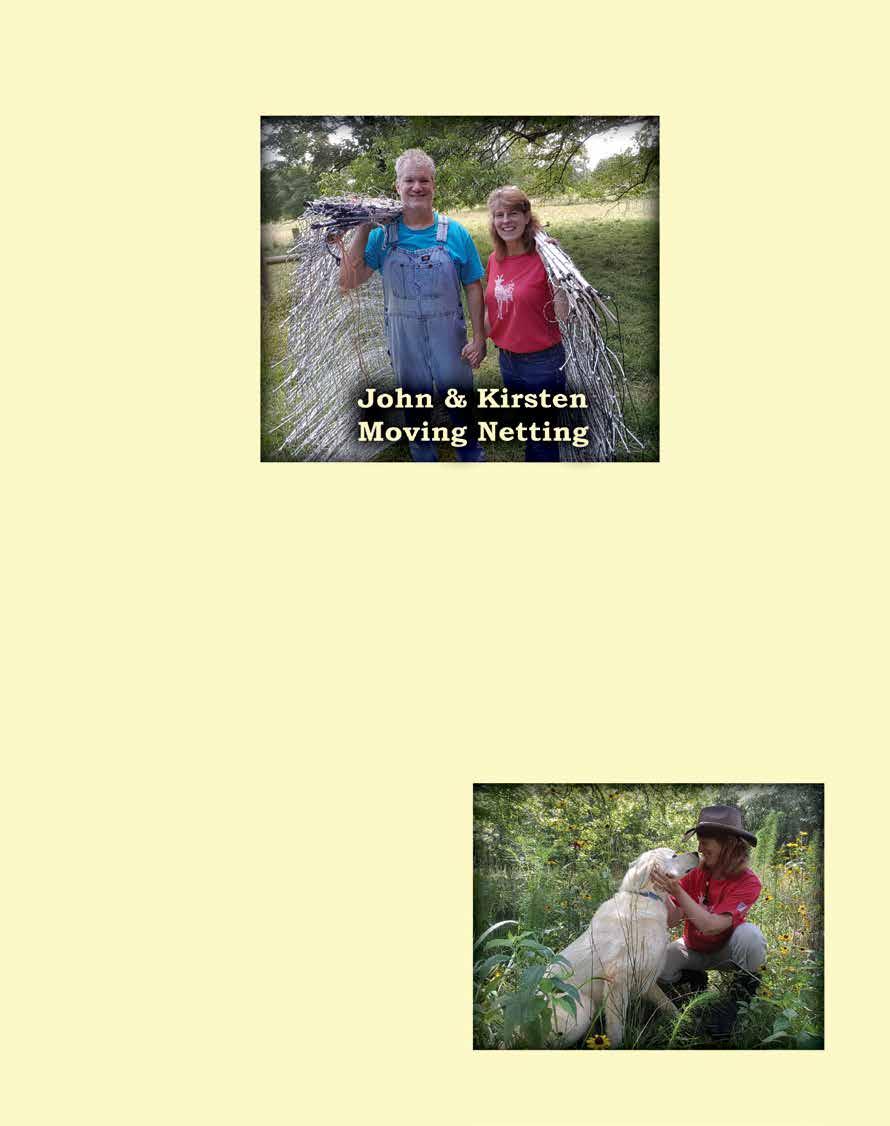


the crossroads of Texas, is located at the junc tion of Highways 281 and 84, an hour from Waco, 1½ hours from Austin, and two hours from DFW. According to their chamber website, Evant, once a thriv ing farming community, had slowly dwindled to a passthrough town between Hamilton and Lampasas. But now, with the involvement of the entire community, Evant is be coming a full family destination.
One of those community members that have taken a partic ipation to seeing the revitalization of Evant is the Drennan family. John Drennan’s paternal great-great grandparents, Pompey and Ellen Callie Lee Burney, moved to Evant in 1884. Their son, John W. Burney, operated the Burney Hardware Store on the west side of the square until around 1950. Drennan’s ma ternal great-great grandparents settled in the adjoining Bee House community around the time of the Civil War. Drennan spent summers with his grandparents in Evant, and remembers the thriving town as it was in the 1970s.
When the opportunity arose to pur chase a former hunting preserve on the land where Coryell, Hamil
ton, and Lampasas counties come together, the Drennans jumped on it. They bought the nearly 1,000 acres, crossfenced it, built roads, brought in more exotic animals, in stalled cabins and RV sites, and opened Buena Vista Wild life Safari and RV Park on January 23, 2019.

The Drennans both have fond memories of the simpler life when they visited their grandparents as children, and de signed Buena Vista to have an “old home” feel. They want ed it to feel like you’ve stepped back into your grandparents time; tapping back into the idea of the letting kids use their imagination which is why there are no televisions in cabins (BUT free wi-fi is available throughout the property).
They are constantly adding new amenities to the Park, which in cludes a petting zoo; a swimming hole and a fishing hole; an orchard and a chicken coop (guests are often treated to free eggs!); a dog run and horse pens; and a walking path with old farm implements on display. The grounds also include a beauti ful Event Center, with a full kitchen, living room, and dining room that is available to rent for corporate functions, weddings, and more.
Keeping in the vane of “old home” feel, they even have an old-fashioned playground which boasts a see-saw. D’Ann commented that many of today’s children have never ex perienced such a contraption and they have had to pull out the ice pack from time to time. However such a simple thing as a see-saw teaches teamwork, communication and motor skills. There is also a stage area for their own play ful imaginations to perform. The goal is to gives kids that creative outlet on this new adventure.
Although some may have a first impression from Highway 281 as “simply a large parking lot,” once one ventures onto the property they are met with breathtaking views. Their RV Park hosts 35 sites, and they even have the option named “the bird’s nest” which is a fifth wheel available for overnight rental in case one is unsure of the RV life, and wants to give it a try. The RV Park is adjacent to the Wild life Safari, so you will have beautiful views from anywhere in the Park.
They also have three cabins, with beds for five. The Orange Eland Cabin is handicap accessible (except for the upstairs loft), with a ramp to the front porch. It is pet and ser vice-animal friendly. The Blue Wildebeest and Red Stag Cabins are allergen-free with no pets allowed. The newest addition to their lodging is “the bunkhouse” which sleeps ten to twelve people and is pet friendly.
The Safari is home to over 25 species of animals that live in a natural environment on 325 acres of land. The remain ing land is held for private management of the animals and to rotate herds and stock. The road through the Safari is 3.5 miles long, and takes about an hour. You can drive it in the comfort of your own car, or rent the party bus for a fun trip through with people in your “pod.”
Some of the species, like the donkeys and the bison, are at tention-hounds and come right up to the car. The property maintains its native landscape, offering brush wall screens for animal cover. Therefore, others are more like animals on a real Safari, and you have to look for them.

D’Ann says they designed their facility to be a little differ ent: “We wanted the animals to live in the most natural, healthy environment possible. We feed daily. So when you come through with food, the animals aren’t starving. They get to choose whether they want to come see you.”
The Drennans put the animals first in all of their planning, and it is evident; they carefully choose a selection of spe cies that do not inter breed, because they keep an all nat ural habitat.
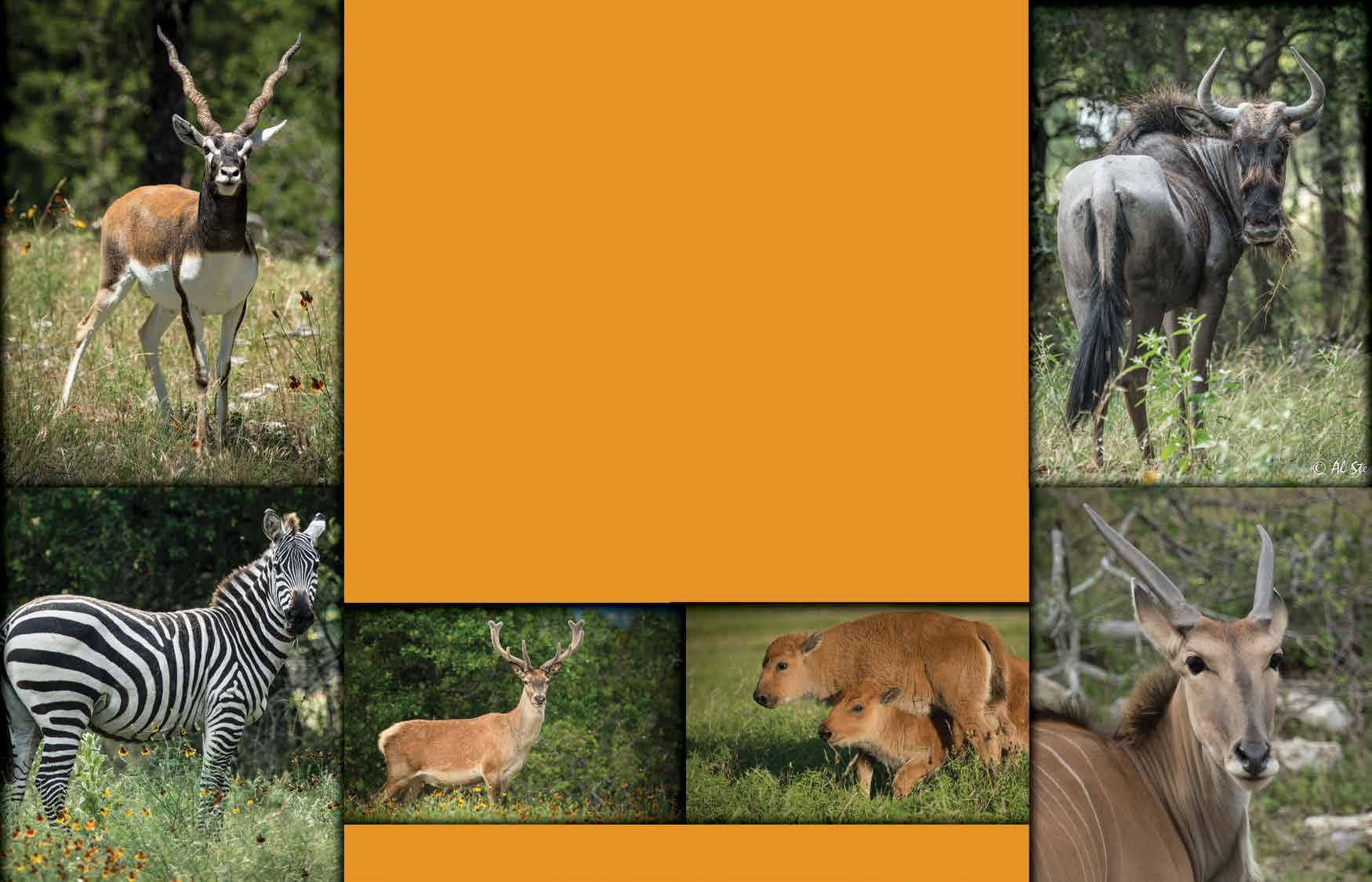
Of the different species there are many that have become favorites over the past year. One of D’Ann’s favorite is the Eland. It is one of the world’s largest antelope (just small er than the Giant Eland) and can jump straight up in the air to ten feet! In Africa, Elands have been domesticated and farmed for meat and milk – just like a cow. Another species of interesting note is that of the Scimitar Horned Oryx. They have horns, not antlers; they never shed, but they can break and never grow back...this may have in spired the legend of the unicorn. They had become extinct in the wild, until 2016 when 23 were released into the wild in Chad (Africa).
You will see something different on every visit. Come in the Spring to see the babies; in the Summer to feel like you’re on an African Safari; in the Fall and Winter to see the antlers. Whenever you choose to visit, we know you will love our animals as much as we do!
A bit of inside information is this is the proper day trip. It is important to prepare oneself not to see everything all at once. As explained these animals are in as much of a nat ural habitat as possible and therefore don’t always want to be seen. Ideally take a couple of trips through the safari, once in the morning where you may see one group of
animals. Spend time in the other areas of the park, grab a lunch either in town or enjoy your own picnic. Then travel the safari again, and see if you can find new animals that may have been a bit more shy earlier in the day. Most who have visited and truly enjoyed their time, understand that it is necessary to slow down and enjoy the park in its en tirety. At Buena Vista Wildlife Safari we have an absolute 5 MPH speed limit at all times throughout our park. Our hope is that your experience with us can be a sanctuary from the hustle and bustle of everyday life. So take it slow, enjoy all the wonderful sights, and keep it safe for the an imals.
John and D’Ann say that building Buena Vista was a fami ly affair. “Our daughter, Kat, did a lot of the artwork that you see hanging in the cabins, designed our logo, t-shirts, and ran our Instagram account. Thomas, our son, loves working outside, so he has helped build the pavilion over the Petting Zoo and most recently helped remodel ‘The Bunkhouse’. which is our largest cabin for rental.”
The Drennans say one of the best parts of building Buena Vista is becoming involved and connected with the com munity: “We have the best staff and guests at Buena Vista! It has such a happy vibe, which spills over into the com munity,” says John’s wife, D’Ann.
Buena Vista Wildlife Safari is open every day of the year except Thanksgiving and Christmas. You can find more information at buenavistawildlifesafari.com or by calling 254.791.5441. If you are interested in growing your busi ness in a building in downtown Evant, call 254.781.3138 for leasing information.

American Highland Cattle Association
Arapaho Alpacas
Arroyo Seco Alpacas
Birch Lake Farm 18
Boulder Meadows Highlands 17
C&M Acres Fiber Mill & Alpacas
Champion Genetics
Chocolate Horse Farm
Commanders Place Longhorns
26
20
Creachann Gleann.................................................................... 16
Deschutes County Fairgrounds Expo Center
DJ’s Classic Alpacas
Donna Wallace
Four T Acres
Gleann Brook Acres Highland Cattle
Gulf Breeze Alpaca Ranch
Heartland Highland Cattle
Kandy Coated
Lewis Mill Ranch
Lone Wolf Ranch
Long Hollow Suri
Macedo’s Mini Acre
Please
Maples
31
Meadowbrook Gypsies.............................................................. 1
M&W Ag Supply 19
Newer Spreader 25 Oxy-Gen 34-35
P&C Cattle Pens
Prairie States Insurance Agency, Inc
Rach-Al-Paca Fiber Processing
Raynay Alpaca Farm, LLC
Running Arrow Farm, LLC
Schon Boden Farms
Silver Meadow Gypsies
Simple Soil Solutions

Spring Canyon Alpacas
Star Lake Tack
Sullivan Supply
Sunrise Supply, LLC
The Alpaca Yarn Co
West Penn Alpacas
World Class Miniature Horse Registry, Inc
think of the new issue
Cover,
26
Back Cover PH White Co
11
11
9
13
18
from
the
make new ones. The first issue is always the
come on
We hope to
We would like to be a
feedback of our clients
magazine;
readership.
